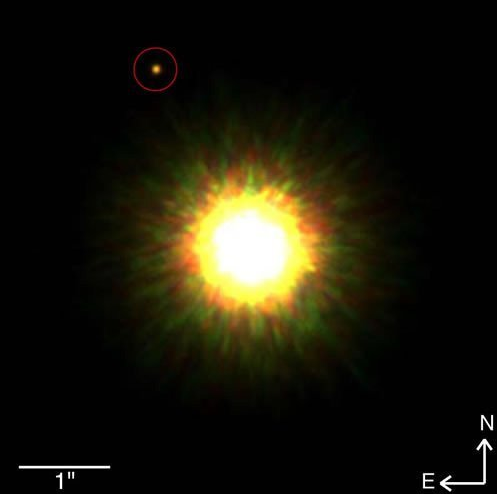
Crazy! Observers and astronomers have discovered a planet orbiting around a faraway star recently with a mass eight times that of Jupiter.
Really? COOL! Is this where the Coneheads live???
Obviously, the little circled one in the mid-upper-left of the picture is the planet that is possibly a planet. Orbiting around that big bright star in the middle, Star System 1RXS J160929.1-210524 (or 1RXS 1609 for short), the little planet there is actualy a monster planet, according to astronomers and other space-types.
Space types? Good lord, I need to get a better thesaurus.
From an article at Space.com – the discovery and study of this monster planet:
Lafreniere and his research team firstannounced their planet’s discovery in September 2008. At the time he was at the University of Toronto, but is now at the University of Montreal and Center for Research in Astrophysics of Quebec.
In 2008, the researchers claimed that the discovery also represented thefirst picture of a planet that orbits around a star similar to our sun. Other astronomers have also made similar claims, including a 2004 discovery of an object that could be a planet or a type of failed star called a brown dwarf.
“Back in 2008 what we knew for sure was that there was this young planetary mass object sitting right next to a young sun-like star on the sky,” Lafreniere said.
The close proximity of the two cosmic objects seemed to suggest that they were associated with each other, but there was a possibility – albeit unlikely – that they were unrelated and had only aligned in the sky by chance. One of the objects might have been closer or farther by considerable distance. So more observations were required to confirm the cosmic find.
The results of the study will be published in an upcoming issue of The Astrophysical Journal.
The system, known as 1RXS J160929.1-210524 (or 1RXS 1609 for short), will give scientists a unique example to study, as its extreme separation from the star seems to challenge common planetary formation theories.
“The unlikely locale of this alien world could be telling us that nature has more than one way of making planets,” said the study’s co-author Ray Jayawardhana of the University of Toronto. “Or, it could be hinting at a violent youth when close encounters between newborn planets hurl some siblings out to the hinterlands.”
The team of astronomers initially detected the exoplanet using the Gemini Observatory in April 2008, which made it the first likely planet known to orbit a sun-like star that was revealed by direct imaging. At the time, the researchers also obtained a spectrum of the planet and were able to determine many of its characteristics, which are confirmed in the new study.
“In retrospect, this makes our initial data the first spectrum of a confirmed exoplanet ever!,” Lafreniere said.
The spectrum illustrates absorption features due to water vapor, carbon monoxide and molecular hydrogen in the planet’s atmosphere.
Cool! But wait – is it extrasolar if it’s orbiting another system’s – uh, solar?






Here’s me waxing pedantic:
Yes, it is extrasolar, because the “solar system” refers only to our sun, Sol. In that case, it’d just be referred to as a star system.
That was my failure at making a solar system joke. Thanks for showing me that it wasn’t funny! : )
Comments are closed.